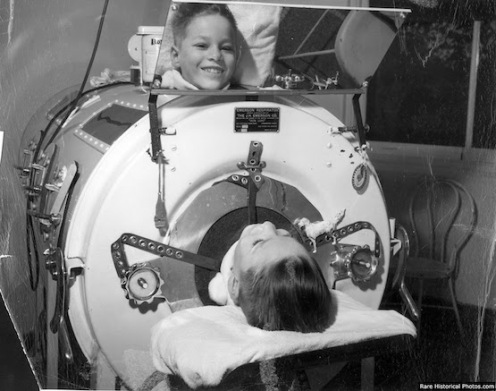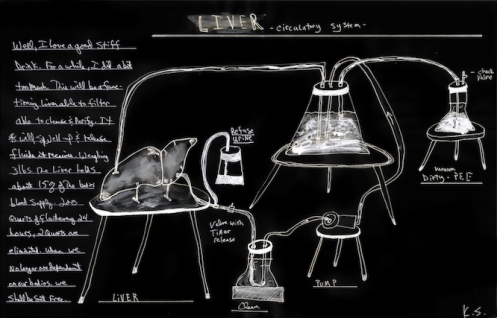Organs Sound The Body
Organs Sound The Body

(Size: H:4’ W:4’ L:3’)
I propose to create functioning human organs in a poetic way.
In these times of the health care crisis, I turn to creating artificial body parts, backups if you will!
•
•
A pair of Silicone lungs breathe from a radio signal bounced off of audiences breathing chest. Bellows is triggered causing lungs to inflate and deflate. The exhale of the lungs provides breathe for a Pipe organ giving voice to breathe. These are artificial human lungs that breathe mimicking the audiences breathe, expanding and contracting with each breath. Each interaction is unique according to the output from the volunteer’s data. The air exhaled will breathe life into a 3-D printed Pipe Organ. It’s various notes and tones registering the changing breath of the audience and particulate contamination in the air. This project, with it’s visceral connections to life, aspires to humanize technology through a poetic and engaging assemblage of machines, materials, and metaphors. I am unlocking the mysteries of universe while honoring and referencing the value of science. I hope to articulate the experience of existence and reality while incorporating scientific reality in this era when the sciences under attack.
+++++++++++++++++++++++++++++

HEART
HEART VIDEO
+++++++++++++++++++++++++++++

KIDNEY
VIDEO OF THE KIDNEY
+++++++++++++++++++++++++++++
The sensors sense human volunteers’ organs trigger 5 artificial organs.
Each artificial organ triggers a pipe organ. Can the audience “collaborate” to perform a tune together or is it pure noise? Can multiple humans sync their hearts, kidneys, lungs, touch and brain to create a “song”?
+++++++++++++++++++++++++++++

1/18/18
Functioning Artificial Organs
I propose to create artificial human organs. I will 3-D print auxiliary lungs for myself. The lungs will be filled with a flexible malleable skin expanding and contracting with each breathe.
The lungs are operated by an audience that will trigger sensors activating it’s breathe in a unique fashion each time according to the output from the audience volunteer’s output data. Hence the lungs breathe will correlate to the audience’s breathe swelling and retracting, pushing out between the 3-D ribs. The exhale will breathe life into a French horn, it’s notes and tones changing accordingly.
•

•
I propose to create functioning human organs in a poetic way.
I will 3-D print a scaffold for a pair of lungs. This scaffold will house a thin flexible membrane inside. The scaffold will be lined with a malleable skin/liner that can respond/inflate to it’s job.There will be a bellows, and valves to route and pump air into them. There will be a filter system in the lungs to visually see any pollution the lungs “breathe”. There will be a pollution sensor embedded inside the lungs activating certain low notes on the French horn when it senses dangerous levels.
The lungs are operated by the audience that triggers sensors activating them in a unique fashion each time according to the output from the volunteer the sensor picks up. A sensor detects the audience’s breathe and aura and recreates breathe. This is a way to visually see and hear one of the fundamental of human existence, breathing. I have designs to build a Heart, Liver and Kidneys as well. If I can finish the Lungs I will start on the Heart.
What is it like to make your own functioning prosthetic organs? To print something that speaks directly to the implications of 3-D printing. What does it mean to print backup organs?
This is a way to reflect on our environment and clean air. For instance the air “inhaled” by the bellows could be inhaled from different environments, The Berkeley hills, work environments, downwind from EastBay MUD for instance, to test, monitor and reveal our air’s contents. I will take this finished project to these assorted sites to test, experiment with them there.
It is now possible to maintain life activity even after it has stopped, it is possible to maintain a person alive but devoid of autonomy. The autonomy is granted by a machine. I could even reverse this and have a human heart feeding machines granting them energy, and therefore, life.
You have technology beyond anything I have worked with yet which would allow me to realize this project/experiment. After decades of building robots this would up my game immensely. I hope to tap into your brain trust and work with some of you.
Eventually this project would consist in printing multiple organs, hands, kidneys, hearts, lungs, fingers, eyes, feet, a mouth and cheeks (blowing, whistling)….to not just replicate but to recreate and interpret and to activate these body parts. If there is time I will start on the next body part.
Can I build sensors that sense the human soul?
I aspire to go beyond utilitarian rationales and capitalism to poetry, this is one of the most noble functions that biotechnological art can perform. I am referencing science fiction and historic scientific experiments as a way to champion science. These human organs are a metaphor for survival, the health care crisis, play and facing the aging process.
I suppose lungs will go pretty quick on me since I have worked in toxic trades all of my life, smoked and cancer kills everyone in my family.
The lungs will breathe correlating to the audience’s breathe via a sensor, swelling and pushing out between the 3-D ribs. The exhale will breathe life into a French horn, it’s notes and tones changing accordingly. On average, a person at rest takes about 16 breaths per minute. We 960 breaths an hour, 23,040 breaths a day, 8,409,600 a year. Unless we get a lot of exercise. The person who lives to 80 will take about 672,768,000 breaths in a lifetime.
We breathe around an average of 500 ml of air in 1 normal breathing. The lungs already have around 3 litres of reserve breathing.
The air that is inhaled is about 20-percent oxygen, and the air that is exhaled is about 15-percent oxygen, 5-percent of the volume of air is consumed in each breath and converted to carbon dioxide. We use about 550 liters of pure oxygen (19 cubic feet) per day.
•

•
HEART

•
LIVER

•
KIDNEYS

•
Thanks to Stochastic labs and my buddy Jon Foote this is happening!
•
